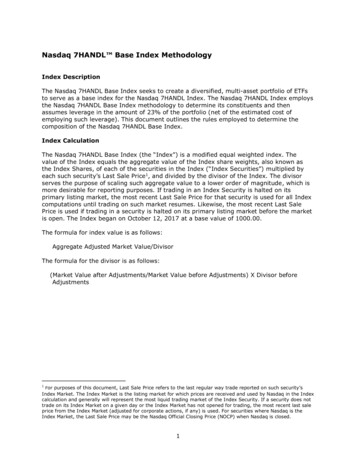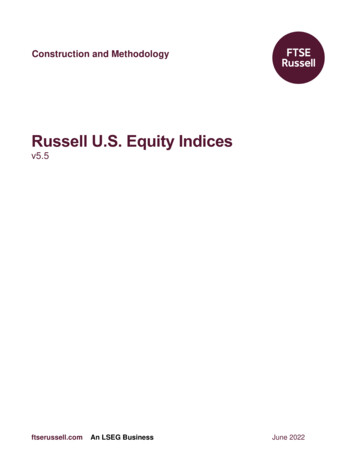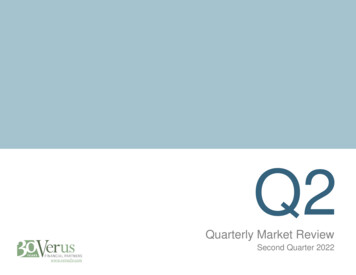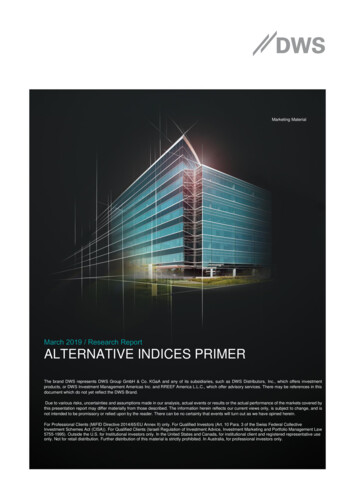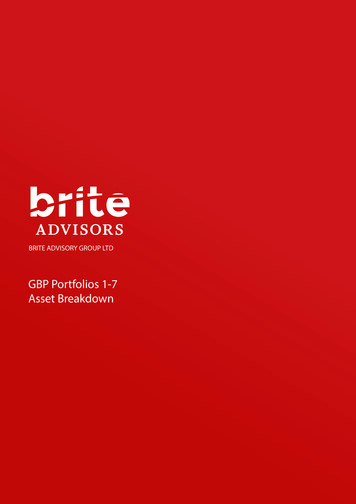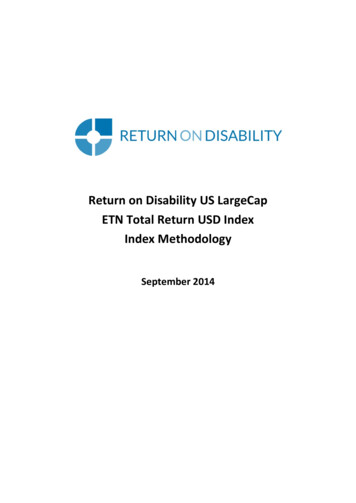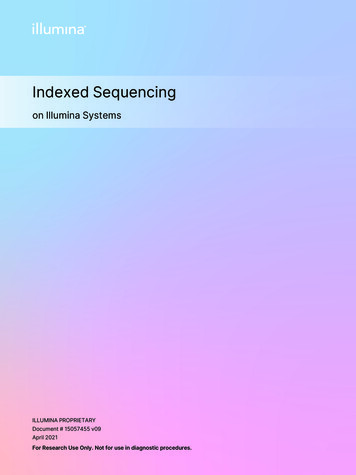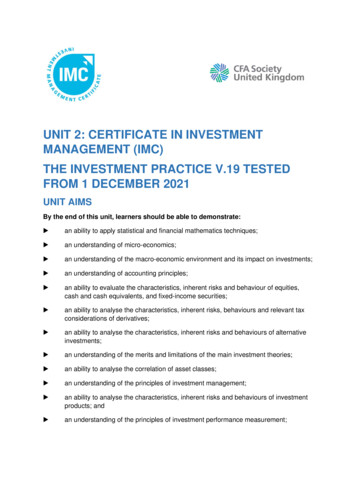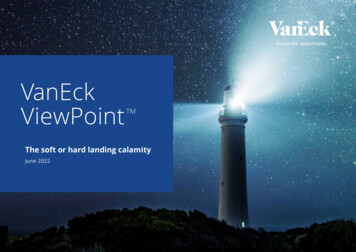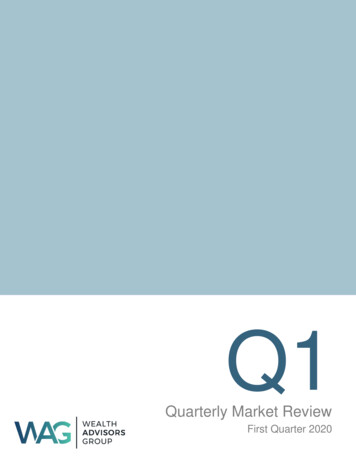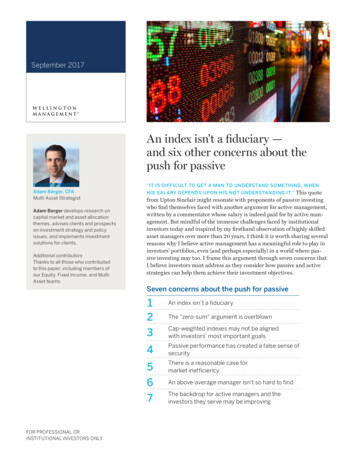
Transcription
September 2017An index isn't a fiduciary —and six other concerns about thepush for passiveAdam Berger, CFAMulti-Asset StrategistAdam Berger develops research oncapital market and asset allocationthemes, advises clients and prospectson investment strategy and policyissues, and implements investmentsolutions for clients.Additional contributorsThanks to all those who contributedto this paper, including members ofour Equity, Fixed Income, and MultiAsset teams.“It is difficult to get a man to understand something, whenhis salary depends upon his not understanding it.” This quotefrom Upton Sinclair might resonate with proponents of passive investingwho find themselves faced with another argument for active management,written by a commentator whose salary is indeed paid for by active management. But mindful of the immense challenges faced by institutionalinvestors today and inspired by my firsthand observation of highly skilledasset managers over more than 20 years, I think it is worth sharing severalreasons why I believe active management has a meaningful role to play ininvestors’ portfolios, even (and perhaps especially) in a world where passive investing may too. I frame this argument through seven concerns thatI believe investors must address as they consider how passive and activestrategies can help them achieve their investment objectives.Seven concerns about the push for passive123FOR PROFESSIONAL ORINSTITUTIONAL INVESTORS ONLYAn index isn’t a fiduciaryThe "zero-sum" argument is overblownCap-weighted indexes may not be alignedwith investors’ most important goals4Passive performance has created a false sense ofsecurity567There is a reasonable case formarket inefficiencyAn above-average manager isn't so hard to findThe backdrop for active managers and theinvestors they serve may be improving
September 2017Factors, indexes, andpassive investing: A recipefor confusionThe growing popularity of factor investing and the rise of “indexes” that arenot based on pure market-capitalization weighting have added a new twistto the active/passive debate. Investorsare clearly enthusiastic about indexesthat reflect investment concepts suchas value, momentum, low volatility andcarry (as evidenced by the fact thatthere are now more passive indexesthan there are stocks in the US1). These“factors,” which can help explain portfolio results and may earn a premiumover time, likely take advantage ofsome of the potentially persistent market inefficiencies that we discuss onpage 7. But they are not passive.Once a portfolio is constructed usingany criteria other than market-capweighting, some of the potential benefits of passive investing — namely,minimal rebalancing or trading andthe ability to accept additional capitalwithout distorting the portfolio —evaporate. What’s more, as discussedin our paper, “The Last Smart BetaPaper You’ll Ever Have to Read,”2 webelieve using an index-like approach tocapture these factors could, in manycases, lead to suboptimal results overtime. Indexes may be great vehicles forpassive investing, but their transparency, simplicity, and static nature areoften the enemies of successful activemanagement. And, make no mistake,“index-like” strategies that hold a subset of the market rather than the entirecap-weighted market are active strategies — just not, I would argue, verygood ones.1Source: Morgan hope-beneath-hype2FOR PROFESSIONAL ORINSTITUTIONAL INVESTORS ONLY2Wellington Management1. An index isn’t a fiduciaryPassive investments based on market-cap-weighted indexes have an undeniable appeal. Their costs are low and they are scalable, with the ability, intheory, to hold an infinite amount of capital while preserving the appropriate relative weights between stocks and with limited rebalancing or tradingneeded over time. (Note that I consider any portfolio that deviates frommarket-cap weighting to be “active” even if it is based on an “index.” Formore on this point, see the sidebar at left.)But an index is not a fiduciary. An index is defined by a set of rules (or, insome instances, by a committee) that has no specific reference to the interests or constraints of any investor. It defines an opportunity set withoutasking whether that opportunity set is aligned with the investor’s objective.To put it more bluntly, every investor has a reason for investing, but that reason is not the focus of those who create and manage cap-weighted indexes.A fiduciary, by contrast, is a person or organization that has two keyresponsibilities with respect to its clients: a duty of care, meaning the manager must know the client and offer the skill and care of a prudent adviser,and a duty of loyalty, meaning the manager must at all times put the client’s interests first. Historically, active management was primarily aboutmeeting these fiduciary obligations. For decades before passive investmentvehicles came into being, the role of an active manager (which is to sayany manager) was to provide an investor with access to a particular market and, critically, to do so in a way that was aligned with the investor’sobjectives. There was a clear focus on the interests of investors and on thesuitability of the securities chosen, whether that meant seeking to protectthe investor from market frenzies, overly speculative investments, or companies with poor management or corporate governance.The now commonplace idea that active management is about beating acap-weighted market index is a relatively new one that only came aboutonce passive, cap-weighted strategies were broadly available and relativelymainstream. It is, in my view, an unfortunate idea for both investors andmanagers because it concentrates attention on a single quantitative measure that is apt to be misused. To understand whether a manager is actingas a good fiduciary requires judgment, nuance, and a keen understandingof portfolio holdings (as well as their rationale). It also requires recognitionthat the path to outperforming in the long run often entails some — andperhaps more than some — short-term disappointment (as we discuss onpage 9). By contrast, to understand whether a manager is outperforming anindex requires only simple math.Investors contemplating passive strategies should therefore considerwhether the index is sufficiently aligned with their objectives or whethera fiduciary can construct a portfolio that — after costs — will be betteraligned. The notion of a “fiduciary” test for passive strategies may seemalien, but I think there is evidence that investors already recognize theimportance of testing passive strategies against their objectives. We cansee this in the way they apply the often-cited “zero-sum” argument forpassive management.
September 20173Wellington Management2. The "zero-sum" argument is overblownProponents of passive make the case that investing is a zero-sum game,meaning that the cap-weighted index is the full investment set and forevery investor who deviates from that set and outperforms it, someoneelse has to underperform it. Against this backdrop, attempting to outperform the index, after fees and costs, is viewed as futile — so passive is thelogical approach.In practice, however, investors are inconsistent in how they apply the beliefin a zero-sum world. They tend to be comfortable applying it to a marketsuch as large-cap US equities, but rarely to wider investment sets. Forexample, the current global market cap is roughly 40% equity and 60%fixed income (Figure 1). If the zero-sum argument holds true, then investors should accept that their portfolios will achieve the same return as thatmix and not seek to do any better. But investors typically hold substantiallymore equity and less fixed income. Indeed, a 40% equity/60% fixed incomemix would be the inverse of the 60% equity/40% fixed income paradigmthat has guided investors for decades and, as indicated by surveys3 of institutional investors, continues to do so.Why don’t investors use the 40%/60% mix that the zero-sum argumentwould suggest? It is simply not aligned with their objectives. Similarly, veryfew investors hold a global equity portfolio that is truly cap-weighted —there’s typically some home-country bias and perhaps some avoidance ofcertain countries (for example, some global portfolios have systematicallyunderweighted Japan for long periods).Figure 1If it’s a zero-sum game, why don’t we all invest like this?Global market capitalizationEquityFixed incomeFixed income includes 5.1% global real estate. Source: Financial Analysts Journal, Vol.70, Issue 2; “The Global Multi-Asset Market Portfolio 1959 – 2012,” Ronald Q. Doeswijk,Trevin W. Lam, Laurens Swinkels3See, for example, Greenwich Associates’ 2015 USInstitutional Investors survey, which found averageequity and fixed income allocations of 54% and35%, respectively.FOR PROFESSIONAL ORINSTITUTIONAL INVESTORS ONLYFaced with a passive approach that is not aligned with their goals, investorsdo not hesitate to deviate from market-cap weighting in the hope of achieving more favorable results, even if they know that for them to outperformthis “benchmark,” someone else must underperform it. I believe investorsshould be equally open to deviating from other cap-weighted stock andbond indexes, as these often may be poorly matched with their goals.
September 20174Wellington Management3. Cap-weighted indexes may not be aligned withinvestors’ most important goalsHere are a few examples of what I consider to be “structural” misalignment, where the cap-weighted index holds meaningful exposures that maynot be linked to an investor’s goals.Two notable periodsof extreme change inindex compositioncome from theTMT bubble of thelate 1990s and theJapan bubble adecade earlier.Emerging market indexes may not deliver what investors are seeking.Ask investors why they allocate to emerging markets and they will oftencite the growth opportunities expected to develop as these countriesundergo a fundamental shift in the size and composition of their economies. But the composition of emerging market indexes is often dominatedby “first generation” companies that were able to grow and profit whenthese countries were in the early stages of development (e.g., naturalresource companies and exporters). Companies with the potential to benefit from future domestic economic development (e.g., health care andconsumer services) are often only a small minority of index holdings.Investors have a shrinking tolerance for drawdowns. Many pensionfunds, endowments, and foundations — having lived through the globalfinancial crisis (GFC) — have come to realize that they cannot withstandanother downside event of similar magnitude, especially if the reboundfrom a future crisis is not as strong as the most recent experience. Forthese investors, the very structure of a cap-weighted index — which doesnot take into account diversification or risk — may be poorly aligned withtheir risk tolerance.Fixed income indexes serve no master. Fixed income indexes —both single country and global — have the largest weightings in the mostindebted issuers. No thought is given to the need to diversify across sectors or to assess an issuer’s credit risk. (For more on the limitations ofpassive fixed income strategies, see our paper “Six reasons to stay activein fixed income.”4)Moreover, the composition of these indexes can change wildly. It seemsreasonable that an investor might seek a US bond portfolio that is allocatedin thirds to government loans, agencies, and corporates. But the ratio ofthese three sectors in the Bloomberg Barclays Aggregate Index is quitevariable over time, and it is far from clear that the drivers of those variations are relevant to a typical investor.This variability of passive indexes extends beyond fixed income. ConsiderFigure 2, which shows some of the remarkable changes in the S&P 500over the past quarter century. Would an investor who seeks diversifiedexposure to major sectors of the US economy really want to see some exposures in the portfolio double while others are ons-stay-active-fixed-incomeFOR PROFESSIONAL ORINSTITUTIONAL INVESTORS ONLYTwo notable periods of extreme change in index composition come fromthe technology, media, and telecommunications (TMT) bubble of the late1990s and the Japan bubble a decade earlier. In the former example, the UStechnology sector grew from 8% of the S&P 500 at the beginning of 1995 tomore than a third of the index (34%) in mid-2000, before falling to a low of13% in September 2002. In the case of the Japan bubble, Japan went fromless than 4% of the MSCI World Index at year-end 1969 to 15% at year-end1979 to a peak of 44% in mid-1989.
September 20175Wellington ManagementI believe that passive investors, who simply go along for the ride as bubbleslike these inflate and pop, are in a sense taking on riskier market betsthan the “old-school” fiduciary active managers described earlier, who intheir day likely created portfolios that were more stable and balanced thantoday’s passive strategies.Figure 2Just along for the ride?Percentage change in S&P 500 weight since 1990400FinancialsInfo techTelecomMaterials3002001000At the end of theday, I believe thatmost fixed incomeindexes are notwell aligned withinvestor 620082010201220142016Sources: FactSet, JPMorgan Asset Management: Standard & Poor’s As of 31 December2016 Real estate was separated into its own sector in 2016 but for simplicity’s sake, isincluded in financials here.At the end of the day, I believe that most fixed income indexes are not wellaligned with investor objectives. Broad global indexes of stocks and bondsmay also be poorly aligned, especially when substantial shifts in countryweights occur over time for reasons that may have little to do with investment fundamentals. Single-country indexes can be poorly aligned if theyoffer insufficient diversification; for example, if they are dominated by1 2 sectors — or, worse, 1 2 companies (e.g., at its peak in 2000, theCanadian telecom company Nortel accounted for more than a third of thevalue of the TSE 300 Index). As a result, investors should consider whetheractive approaches may be better aligned over time with their fundamentalinvestment objectives.Cap-weighted indexes may also be misaligned with investor objectivesbecause of distortions between true market-cap weighting and the freefloat-weighted calculations used by major index providers. Float-weightedcalculations will tend to underweight companies where the management,board, and employees have large ownership stakes, even though management of these companies may be better-aligned with investor objectives.For more on this topic, see our recent paper, “Insiders out: Why index ownersmay be getting less of the good uff5FOR PROFESSIONAL ORINSTITUTIONAL INVESTORS ONLY
September 20176Wellington Management4. Passive performance has created a falsesense of securityI have not yet addressed a very important source of potential misalignment, which may be paramount over the next decade. I believe investorsoften take it for granted that passive index-based equity strategies (as a“return-seeking” asset) will meet their return objectives over the mediumto long term. But there is a very real chance that cap-weighted portfolioswon’t deliver the low double-digit (or even high single-digit) returns thatinvestors may need in the coming years. Historically, there have beennumerous examples of equity markets — including Germany, Japan,France, and even the US — experiencing decade-long periods of flatreturns (Figure 3). The pain those weak returns have inflicted on institutional portfolios has been substantial.Figure 3Countries that have experienced extended periods of low returnsRolling 10-year total returns (annualized)CountryTime period% of times 0%% of times 5%Worst returnGermany (DAX)1900 – 201618%41%-32%Japan (TOPIX)1920 – 201615%29%-7%United States (S&P 500)1900 – 20165%21%-5%France (CAC)1900 – 20164%21%-5%United Kingdom (FTSE)1900 – 20161%24%-1%Sources: Global Financial Data, Datastream, Wellington Management Not representative ofan actual account or investment. Index returns do not reflect the impact of fees or expenses.PAST RESULTS ARE NOT NECESSARILY INDICATIVE OF FUTURE RESULTS AND ANINVESTMENT CAN LOSE VALUE.Looking forward, we recently conducted a study of return expectationsusing data from eight major investment consultants. We found that onaverage the consultants expect equities to provide a return of 7% over thenext 5 – 10 years.6 That would not be sufficient to allow many public pensions, endowments, and foundations to hit their return targets.Of course, investors contemplating equity market performance since theGFC couldn’t be blamed for assuming that stocks will be an evergreensource of growth. Over the past five years, passive strategies, particularlyUS equity strategies, did remarkably well across a range of objectives.Whether the objective was growth, income, growth and income, or lowvolatility, passive S&P 500 exposure delivered strong results, often both inabsolute terms and relative to available alternatives.6Average return expectations were sourced fromeight major investment consultants and were basedon time horizons of 5 ‒ 10 years. Available estimateswere averaged after removing the highest and lowest estimates. Data as of August 2016FOR PROFESSIONAL ORINSTITUTIONAL INVESTORS ONLYBut the post-GFC period has been very unusual. The realized five-yearSharpe ratio for the S&P 500 (1.5 as of June 2017) is in the 98th percentilesince 1960, extraordinarily high relative to the long-term average of 0.4.It seems reasonable to conclude that this performance is not sustainableand the market is likely to deliver a lower risk-adjusted return over thelong term, so investors should not be cavalier about assuming that passiveinvesting in large-cap US stocks will let them achieve their goals.In itself, this caution doesn’t make a compelling argument for activemanagement. Active managers won’t be any better aligned with investorobjectives unless they can outperform passive indexes. Fortunately, I thinkthere is reason to believe they can.
September 20177Wellington Management5. There is a reasonable case for market inefficiencyPassive investing is premised on the belief that markets are reasonablyefficient — that is, that prices are accurate reflections of all available information about a given security. But this assumes an inherent rationality inthe behavior of market participants, and there are a number of compellingarguments, both intuitive and academic, about the forces of irrationality towhich markets are subject.Benjamin Graham,pioneer of valueinvesting, offered acompelling analogy:“In the short run, themarket is a votingmachine, but inthe long run, it is aweighing machine.”One challenge is that “all available information” often means a flood of news,analysis, and commentary that can be overwhelming and perhaps misleading. Behavioral economics offers reasons why market participants may notonly be distracted by this onslaught but also focus on the wrong information and extrapolate it beyond its useful time horizon (Figure 4). Multiplythis irrationality by millions of market participants looking at thousands ofsecurities and you get a recipe for noise, inefficiency, and opportunity.Figure 4Behavioral explanations for irrational investment decisionsOverconfidence — People assume outcomes will fall in a range that is narrowerthan the true range of possibilities.Optimism — People have unrealistically optimistic views of their prospects.Representativeness — People draw conclusions based on skewed or insufficient evidence.Belief perseverance — People tend to stick to their initial conclusions for too long.Anchoring — People form estimates with too much weight on an initial, sometimesarbitrary, value.Availability — People give too much weight to recent or easily remembered events.Loss aversion — People display a strong preference for avoiding losses overexperiencing gains, even in situations where they end up with the same net wealtheither way.Source: Barberis and Thaler, “A Survey of Behavioral Finance”Benjamin Graham, pioneer of value investing, offered a compellinganalogy: “In the short run, the market is a voting machine, but in the longrun, it is a weighing machine.” Put another way, in the short run, the market focuses more on popularity and less on fundamentals. But in the longrun, the market is more likely to weigh the substance of a company andthe results — the cash flows — ultimately win out. This suggests an ongoing opportunity for active managers who can tune out the noise, fight thecrowd, resist the easy solution, and see through to the long-term drivers ofa stock’s performance (particularly in a world where short-term investmenthorizons have reached new extremes, with high-frequency traders measuring holding periods in milliseconds).In the end, my experience leads me to the strongly held belief that even inrobust, transparent markets, such as large-cap US equities (see sidebarbelow), and with all available information in hand, the average or marginalinvestor may be making irrational decisions. And those decisions createopportunities that active managers can exploit.FOR PROFESSIONAL ORINSTITUTIONAL INVESTORS ONLY
September 20178Wellington Management6. An above-average manager isn't so hard to findAs passive proponents often argue, just because markets are inefficient, itdoes not automatically follow that managers or their investors can profitfrom that inefficiency. To be successful in markets where passive indexesare aligned with investor goals, active managers need to be able to addvalue with some consistency. In this case, relative to everyone who deviatesfrom the cap-weighted index, managers must be “above average.”From an investor’s point of view, the goal is to find an above-average activemanager — and indeed one who is far enough above average to compensate for higher fees and transaction costs than passive investing. The goodnews is that if you accept the argument that there is some degree of marketinefficiency, it becomes easier to see how a skilled manager can achieveabove-average results.Active management in US large cap: The ultimate contrarian call?Investors interested in passive often start with their large-cap US equityexposure, with the view that it is likely to be one of the most efficient marketsand therefore among the hardest to beat. There is some academic and intuitive evidence to support that view. The large-cap US equity market has bettercorporate disclosure standards, greater analyst coverage, and broader sectorand company exposure than many markets. Low transaction costs arguablydraw in investors, so there may be more competition for attractive opportunities than in thinner, less liquid markets. The historical evidence suggests thatnet alpha from active management has been lower in the US large-cap spacethan elsewhere.7And yet, the large-cap US market has two characteristics that investorsshould consider before opting to go passive. First, it is noisy, with companieswidely covered not just by analysts but also by the media. The noise-to-signalratio — which I believe favors thoughtful active investors — may be higherthan it is anywhere else. Second, and perhaps more important, the US market is large. It is still the largest market by dollar value in the world, and by ahealthy margin. For US investors, who typically have some degree of homebias, going passive in large-cap US may mean going passive in more than halfof their equity portfolio. Depending on return objectives, this may not be theoptimal approach. Large-cap managers have shown they can outperform (seeFigure 6), and the prospect of less competition (as more investors go passive)may create a backdrop where future results will be even more compelling.Investors may want to consider more global approaches if they aren’t comfortable with active portfolios focused on the US large-cap market but arereluctant to forgo active management of such a substantial component of theirportfolios. The academic data on global equities has been more favorable, andsome of the issues related to crowding and efficiency may be less prominentwhen portfolio decisions are made on a global scale. Even if US companies arewell-covered, for example, there may be meaningfully less research (and capital) focused on how these companies stack up relative to their global peers.Although global investing has attracted substantial capital in recent years, Ibelieve it remains underinvested as a category.See, for example, Joseph Gerakos, JuhaniLinnainmaa, Adair Morse, “Asset managers:Institutional performance and smart betas,”Chicago Booth Research Paper, No. 16-02,November 20167FOR PROFESSIONAL ORINSTITUTIONAL INVESTORS ONLY
September 20179Figure 5Even top-performing managers haveperiods of underperformancePercent of rolling 1-year observations in whichtop-decile managers were behind index or inbottom quartile of eVestment database, 10years ended 31 Dec 2016 (%)40Behind indexUltimately, the value of any security is the discounted value of its futurecash flows, and the price of any security is the market’s assessment of thosefuture cash flows and of an appropriate discount rate. Managers must findsecurities about which the market’s assessment is wrong; but with the benefit of the behavioral economics lessons noted earlier, we can draw somereasonable conclusions about mistakes that market participants seem tomake over and over again. Markets can become too pessimistic when companies and countriesgo through tough times and overconfident when times are good. (Thiscreates opportunities for value managers.) Markets may have trouble pricing in the impact of companies andcountries going through transformational change and growing at ratesthat are unprecedented or hard to fathom. (This creates opportunitiesfor growth managers.) Markets have historically (although perhaps not recently) shied awayfrom boring, more predictable companies whose results are likely to bemore stable over time than those of their peers. (This creates opportunities for quality and low-volatility managers.)Bottom quartile3530Wellington Management2520Notably, these inefficiencies have been observed across asset classes, geographies, and various historical periods.8 Investors seeking “above-average”performance must find managers who can identify and take advantage ofthese and similar opportunities. Amid hundreds of managers competingfor time, attention, and capital, investors should pursue managers with:15105 A strong investment philosophy that explains why they expect to outperform over time and why the market gives them an opportunity todo so A clear investment process that maps the decisions they make asinvestors to this philosophy A mindset geared to the long term, since much of the inefficiency inmarkets likely comes from the average investor’s mindset and behaviorbeing too anchored to the short term A business model that is stable and resilient enough to weather periods of underperformance, since even top-performing managers willunderperform at some point in the cycle (Figure 5) A fee structure that is aligned with expected returns from thestrategy and the client’s interests0USequityGlobalequityInternational EmergingmarketsequityequityUSfixedincomeSource: eVestment Benchmarks used: S&P 500for US equity, MSCI ACWI for global equity, MSCIEAFE for international equity, MSCI EM for emerging markets equity, and Bloomberg Barclays USAggregate for US fixed income.8See, for example, Clifford Asness, TobiasMoskowitz, and Lasse Heje Pedersen, “Value andMomentum Everywhere,” The Journal of Finance,Vol. 68, No. 3, June 2013 and Andrea Frazzini andLasse Heje Pedersen, “Betting Against Beta,”Journal of Financial Economics, Vol. 111, No. 1,January 2014.FOR PROFESSIONAL ORINSTITUTIONAL INVESTORS ONLY
September 201710Wellington ManagementNot every manager will be above average, but I am optimistic about institutional investors’ ability to “separate the wheat from the chaff.” I believethe tests discussed on page 9 — combined with some considerations in thenext section — can help identify managers more likely to succeed in achieving investors’ objectives. As Figure 6 shows, even without distinguishingbetween the stronger and weaker institutional managers, the broad crosssection of active managers has historically outperformed benchmarks. Thedata in Figure 6 is gross of fees and the net-of-fee numbers would be lessfavorable. But, as we discuss in the next section, this 10-year period hasbeen among the most challenging for active management. In the long run,I would expect active managers to enjoy a more favorable backdrop forgenerating returns.Figure 6More than half of institutional managers have added value% of active managers outperforming index, 10 years ended 31 December 201690I am optimisticabout institutionalinvestors’ ability to“separate the wheatfrom the chaff.”60300US Small CapEuropeEmerging MarketsJapanUS Large Cap CoreGlobalPast results are not necessarily indicative of future results. Data is gross of fees and net-of-feeresults may have been less favorable. Source: Mercer Insight — US Equity Small Cap Universevs Russell 2000, Europe inc UK Equity Universe vs MSCI Europe, Emerging Markets EquityUniverse vs MSCI Emerging Markets, Japanese Equity Universe vs MSCI Japan, Global EquityUniverse vs MSCI All Country World, US Equity Large Cap Core Universe vs S&P 500. Datashown in the chart is based on all active managers in Mercer’s manager performance database(in each respective category listed), Mercer Insight, over the 10 years ended December 2016.The Merc
Fixed income indexes serve no master. Fixed income indexes — bothdecade earlier. single country and global — have the largest weightings in the most indebted issuers. No thought is given to the need to diversify across sec- . This variability of passive indexes extends bey
